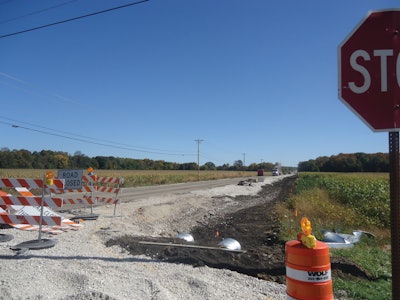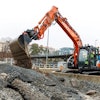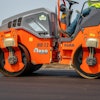
When Wolf Paving, located in southern Wisconsin, bid the 2.75 mile Coffee Road project in New Berlin, WI, they had a small idea of the challenges that would await them, but remained hopeful that their past experience in the New Berlin area wouldn’t occur on this project. The rural stretch is said to be one of the oldest paved roads in the city, rumored to have gotten its name from pioneer settlers travelling through the area and replenishing their coffee supplies on it while headed west. This historic road was in desperate need of rehabilitation.
The project initially included widening and straightening of the current road and re-paving the entire stretch of this major east to west artery through the city.
City officials knew the project between Racine Avenue and Calhoun Road would be massive, but it turned out to be even bigger than expected when sections of the road had to be rebuilt instead of merely repaved, as had been originally planned.
“New Berlin has some challenging soils – a lot of their soils were horrible,” says Riley Stendel, project manager at Wolf Paving. “There’s no doubt that this Coffee Road was built on some really horrible ground. It’s in large sections of lowland and has some drainage issues.”
Stendel and his crew were tasked with rebuilding the road while utilizing the existing roadway rather than removing it, which required significant excavation, with quite a bit of it being at deeper than planned depths due to the unstable soils.
And so in April of last year, the preliminary work began with traffic control and erosion control permits.
Heavy excavation
Wolf Paving partnered with All-Ways Contractors, Inc. for the mass excavation and the rough grading work. “This project is cut into four phases because a large portion has to stay open to local traffic. It’s rare that you can just shut down a road these days,” says Stendel. “New Berlin determined the phasing plan with what research they’ve done on traffic patterns.”
The existing road was 22 feet wide, and needed to be widened out to 34 feet, while leaving the existing 22 feet in place. The project added a foot to each lane, making them 12 feet wide, and five-foot paved shoulders on both sides. Turning lanes were added to the west side and bypass lanes and turning lanes were added at various other locations. Storm sewers were added in two areas. Stendel and his crew worked around trees, bushes and gardens wherever possible to lessen the impact of the wider road.
“If you’re picturing a typical road, you’re going to excavate the edges, put in new base material and asphalt pavement,” says Stendel. “This was a half a reconstruct and the other half was going to use the existing road – making it pretty challenging because the old road is in pretty bad shape. Then factor in straightening the road and the resulting changing center crown location and elevations and it gets interesting.”
“We started doing full depth milling work where there were road elevation changes of up to 5 feet proposed in the three reconstruct sections – so some pretty major earth work,” says Stendel. “We milled the pavement off in these sections and then, after significant excavation, these areas ended up getting a layer of geo-grid, 2 feet of 3” clear limestone, a layer of geo-synthetic fabric, followed by 1 foot of 1.25” limestone traffic bond. This was determined to be the proper road base cross-section for this road and the soils we were finding.” New Storm sewer pipes were incorporated in selected locations as proposed to handle the challenging drainage along some sections of the road
Rebuilding under budget
“If money were no object, there’s no argument that it needed a total reconstruct,” says Stendel. “We would take everything that’s out there and start from square one - widening it, reshaping it completely – but nobody has unlimited budgets.”
Once the stone base was at its finished height, the first binder layer of asphalt was added. New Berlin specified the same material to be used throughout the entire project. “They decided that a E3-9.5mm Superpave mix was to be used everywhere we paved,” says Stendel. “The City of New Berlin is very progressive in their concerns for finished roadway porosity and the potential damage the climate here can inflict on it. Their use of a finer mix throughout the cross section is very interesting and will be something we will be keeping an eye on in the future.”
Once the widened areas had the initial 3” binder layer installed, it was time to transform the look of the road entirely by profile milling the existing road (anywhere from 1 inch to 6 inches)- changing the location of the center crown up to 8 feet in places. “These were real ‘cross your fingers moments’ as we were finding variable existing road thicknesses due to the sheer age of the pavement and these were some significant elevation changes- the possibility of breaking through was very real,” says Stendel. “We had a few isolated spots after profile milling to excavate, rebase, and pave, but overall, it went very well.”
Keep in mind that the widened areas were bindered to elevations that would match the profile-milled existing roadway BEFORE the significant profile milling was done. “Again a real challenge,” Stendel adds.
After the profile milling was completed, they basically had a 34’ wide roadway composed of old and new pavements. It was time to bring this all together. “We went over this combination of old profile-milled and newly constructed widened areas with a thin (1” +/-) layer to level and smooth the road and its ride characteristics,” says Stendel. “Next we put down a product called glass grid. It’s like a fiberglass reinforcement layer between the lifts of asphalt to delay or reduce the amount of reflective cracking that comes through.”
Glasgrids, a form of geogrids, are beginning to gain popularity in areas where stabilization is needed, but elevation and cost are a factors in determining how to obtain the strength. In soil stabilization applications, geogrids distribute loads over a larger area, reducing pumping and shear failures, while maximizing the load bearing capacity of the subgrade.
“In the case glasgrid, it almost looks like a miniature plastic chain-link fence. It gets rolled out and pressed gently with pneumatic-tired equipment. It has a tacky surface on it. It’s almost like putting reinforcing mesh into concrete – to make it stronger,” adds Stendel. “By putting this glass grid in there, they are going to be able to reinforce that existing road, making it a long-lasting project just by that one step.”
Finally a 2” surface layer of asphalt was put down to complete the road paving.
Meeting specs
“We had some high-density requirements on this job,” says Stendel. “We used a MTV Material Transfer Vehicle, MTV, a Roadtec Shuttle Buggy, that allowed us to dump our asphalt out of the dump truck into this transfer vehicle, which can hold 25 tons – the whole truck.”
The asphalt goes up a conveyor into a larger conveyor and into a hopper. The paver has an insert in it that allowed Wolf Paving to put the asphalt into the paver without having to worry about the impact of trucks coming into contact with the paver, keeping material segregation to a minimum, helping to improve the ride quality of the road. “We can concentrate more on the paving and less on the trucks this way,” Stendel adds.
“We also added an additional roller to the rolling team and had pneumatic tired rollers on hand to help meet the super high-density requirements. It’s one of the highest density requirements we have ever seen. It was challenging and new territory for us. It’s far beyond industry standard spec.”
Load limits
Though Coffee Road was never built to carry heavy trucks, some truckers have used the former county road as an alternate route to avoid traffic signals, officials said.
To protect the brand new road, the New Berlin Common Council last week imposed a 10-ton limit on the entire stretch of Coffee from Racine Avenue to Moorland Road. Because most of the work involved repaving, and not upgraded reconstruction from the ground up, heavy trucking would shorten its life, officials explained.
The weight restriction will also retain Coffee Road's intended purpose, officials said. It is designated as a historic residential street, with no businesses along its stretch west of Moorland Road.
Because the subsoil in some places had to be redone and the crews ran into bad weather early on, the project deadline was extended to Oct. 30, 15 days later than the original deadline, which was met.
“New Berlin had been working on the design of this project for 4-5 years before construction began,” says Stendel. “I’ve been doing this for 26 years and this was one of the most difficult projects I’ve ever been on. It’s clear that with their planned budget, their design was the right solution for this job.”
















